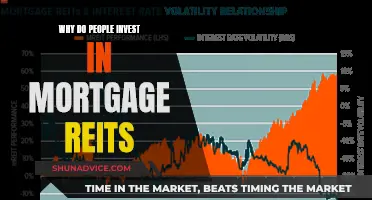
There are many reasons why people don't invest, from a lack of financial means to misconceptions about the amount of money needed to start investing. Many people believe that investing is too risky, that they need to be rich to invest, or that their home is their only investment. These common myths prevent people from building a basic portfolio, which is essential for retirement planning. Other factors include a lack of financial knowledge, distrust of financial professionals, and the perception of high investment fees. Additionally, some individuals may be repeating the financial habits of their parents or previous generations, such as low investment rates among millennials, which can have detrimental long-term effects.
| Characteristics | Values |
|---|---|
| Lack of money | 53% of those who don't invest in stocks say it's because they can't afford to |
| Lack of knowledge | One in five Americans who aren't invested plead ignorance |
| Lack of trust | Nearly one in 10 don't trust stock brokers and financial advisors |
| Perceived risk | 7% think stocks are too risky |
| Myths | People assume investing is too risky, or that you need to be rich to invest |
| Debt | Millennials are burdened by huge college debt |
What You'll Learn

Believing you need a lot of money to invest
Believing that a large amount of money is required to start investing is a common misconception that prevents people from investing. However, this notion is far from the truth. In reality, numerous brokers and apps allow individuals to start investing with a small amount of money. For instance, some apps have a minimum investment requirement of as little as $5, while others allow contributions as low as $100 per month. Additionally, certain funds may waive their minimum investment requirement if an automatic investment of $50 per month is set up.
It is worth noting that a diverse investment portfolio is generally recommended. This means investing in a variety of companies, bonds, and other assets, rather than putting all your money into a single company or asset. This diversification helps to manage risk and is achievable even with a small amount of money. For example, some companies trade for less than $10 per share, and penny stocks can be purchased for less than $1.
The perception that a substantial sum of money is needed to invest may stem from the fees associated with certain investment options. For instance, some mutual funds and exchange-traded funds (ETFs) have minimum investment requirements of $3,000 or even $10,000. However, there are also plenty of options that require only a few hundred dollars to get started.
It is important to remember that investing does not have to be costly, and there are numerous ways to get started with a small amount of money. By taking advantage of the various investment apps and funds available, individuals can begin building their investment portfolios without needing a large sum of money.
While it is true that investing larger amounts of money may lead to more significant returns, it is important to start somewhere and gain experience in the world of investing. Starting small can provide a solid foundation for future investments and financial security.
Where People Invest: Tracking Trends
You may want to see also

Thinking investing is too risky
Many people are hesitant to invest because they believe it is too risky. This perception is not entirely unfounded, as investing does carry a certain level of risk. However, it is important to understand that the level of risk can vary depending on the type of investment and one's financial strategy.
Firstly, it is crucial to recognise that investing is not a get-rich-quick scheme. Investments are typically made for the long term, and there is always a possibility of losing some or all of one's money. Therefore, it is essential to have a comprehensive understanding of the risks involved before committing any funds. This includes assessing your financial situation, such as ensuring that you have control over your household finances, have emergency savings, and are investing in your workplace pension if applicable.
Additionally, the stock market, which is a common investment avenue, has experienced significant crashes in the past, such as in 1929 and 2008. These events can understandably make people wary of investing their money in stocks. However, despite these crashes, the stock market has also proven to be one of the most valuable ways to build wealth over time. For example, even if one had invested in stocks just a few years before the 2008 recession, they would still have seen a return of 72% over a decade. Moreover, since its inception in 1950, the S&P 500 has enjoyed a return of more than 12,000%. Therefore, while there may be setbacks along the way, the historical trend indicates that investing in stocks can be lucrative in the long run.
It is also worth noting that not all investments are equally risky. Some investments, like mutual funds, offer a level of diversification that can reduce the risk of losing money. These funds pool various investments together, minimising the impact of any single loss. Additionally, factors such as age and financial situation can influence one's risk tolerance and capacity. For example, a younger investor has more time to recover from potential losses and can afford to take on more risk compared to an older investor nearing retirement.
Furthermore, it is important to understand the different types of investment risks beyond the volatility of the stock market. These include market risk, inflation risk, interest rate risk, reinvestment rate risk, default risk, liquidity risk, political risk, and currency risk. By understanding these risks, investors can make more informed decisions about the level of risk they are comfortable taking and explore ways to manage these risks effectively.
While investing does involve a certain level of risk, it is not as unpredictable as gambling. By diversifying one's portfolio, conducting thorough research, and seeking financial advice when needed, individuals can make more informed decisions that align with their risk tolerance and financial goals.
FTX: Celebrity Investors
You may want to see also

Lack of trust in financial professionals
A lack of trust in financial professionals is a significant barrier to investing for many people. According to a survey by Morning Consult, a data research company, only around one-third of 4,400 US adults polled said they "tend to trust" investment and wealth managers. This trust deficit is not limited to a particular demographic; it spans gender, ethnicity, income, and age groups.
So, what drives this mistrust? One key factor is the perception that financial professionals are more focused on selling products than providing genuine guidance and insight. The language used by many financial advisors, such as referring to financial offerings as "products," can create a sense of distance and mistrust with clients. Additionally, when financial advisors start by asking about a client's net worth, it may give the impression that they are only interested in their money, rather than their financial goals and priorities.
The way financial professionals communicate and interact with their clients plays a crucial role in building or eroding trust. Instead of explaining and educating, advisors should focus on inquiring and understanding their clients' life goals and priorities. By redesigning the conversation and showing genuine interest in their clients' financial aspirations, advisors can begin to build a foundation of trust.
Furthermore, the focus of financial services firms also influences the level of trust clients perceive. When senior leadership emphasizes increasing assets under management, it sends a message to both employees and clients that generating revenue takes precedence over client impact. This misalignment between stated values and actual practices can contribute to the perception that financial professionals are not trustworthy.
To address this issue, financial services firms and advisors need to shift their approach. By prioritizing client impact and goals, providing genuine guidance, and demonstrating a commitment to data stewardship, security, and reliability, they can begin to rebuild trust and encourage more people to invest.
Investing in People: A Guide
You may want to see also

High investment fees
When it comes to ongoing fees, funds may charge a management fee, also known as a management expense ratio (MER), as well as an administration fee. These fees are usually charged indirectly through lower investment returns. Additionally, some funds may charge an investor/low balance fee if the value of the investment holding drops below a certain level. On the other hand, one-off fees include transaction fees, also known as the buy/sell spread, which are charged whenever a transaction is made, such as investing in or withdrawing from a fund. These fees help cover transaction costs such as brokerage fees, bank fees, and government taxes.
It's important to note that higher fees do not always guarantee better returns. In fact, passively managed funds are often less expensive than actively managed funds, and large-cap funds tend to have lower expense ratios than international and small-cap funds. As a result, it's crucial for investors to understand the fee structure of different investment options and to shop around for the best option for their financial goals.
The high fees charged by some investment funds can be a significant deterrent for potential investors, especially those who feel they don't have enough money to invest in the first place. This is particularly true for millennials, who may be burdened with college debt and struggling to build a budget that allows them to save and invest for the future.
Rich People: Where They Invest
You may want to see also

Lack of knowledge about stocks
A lack of knowledge about stocks is a significant barrier to investing for many people. This is particularly true for millennials, who seem to be repeating the mistakes of their parents when it comes to investing. According to a survey by Bankrate, only 26% of people under 30 are investing in stocks, and more than half of Americans don't own any stock investments at all. While there are many retirement savings programs available, such as 401(k)s, 52% of Americans still report not owning stocks or stock-based investments.
One reason for this could be that millennials claim to know nothing about stocks or the stock market. This is surprising, given that they have access to more information than any previous generation. However, it seems that they are not using this information to educate themselves about investing. Instead, they may be relying on entertainment sources, such as money shows, which may not provide accurate or useful information.
A lack of knowledge about stocks can lead to costly mistakes when investing. It is important to understand the risks involved and to make informed decisions based on financial goals, time horizon, and risk appetite. Investing in the stock market can be risky, and it is important to diversify your portfolio to minimize risk. However, with the right knowledge and strategies, investing in stocks can be a great way to build wealth and save for retirement.
Additionally, it is crucial to remember that many factors affecting stock investments are beyond our control, such as oil prices, stock prices, and interest rates. Focusing too much on these factors can be a waste of time and energy. Instead, investors should focus on their financial goals and risk tolerance to make informed decisions. By taking the time to educate themselves and seek reliable sources of information, individuals can overcome their lack of knowledge about stocks and make more confident and successful investment choices.
Invest in Cars: Buyer's Guide
You may want to see also
Frequently asked questions
Some common misconceptions that prevent people from investing include believing that you need to be rich, that investing is too risky, or that owning a home is a form of investment.
Other reasons people don't invest include a lack of financial knowledge, distrust of financial professionals, and the belief that investing is unaffordable.
Income is a crucial factor in investment planning. Individuals must balance their income with their spending and sacrifices to determine how much they can invest.
Not investing can result in missed opportunities for long-term market gains, which are essential for retirement security. It may also lead to a reliance on social security and living below the poverty line during retirement.
Individuals can overcome barriers to investing by educating themselves about the stock market, seeking financial advice, and creating a budget that allows them to save and invest regularly.







